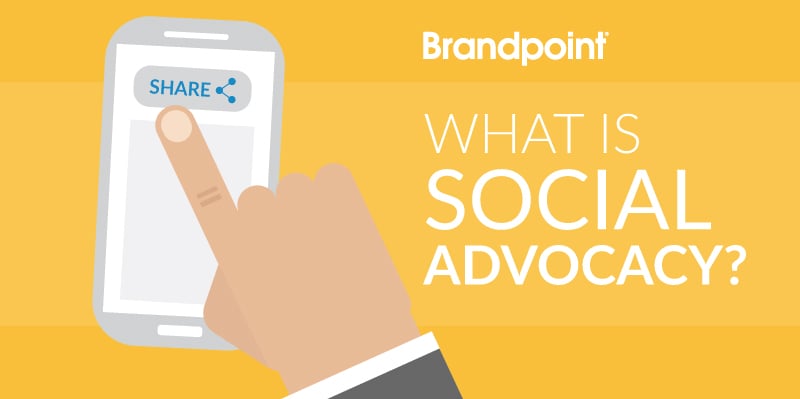During an interview, it can be difficult to explain your strengths and experiences to an interviewer who has never met you before. However, if you have a friend or connection with someone at that company, they might be able to explain to the interviewer why you would be a good fit for the role. If the interviewer trusts the employee who is vouching for you, then the interviewer will be more likely to trust you. This in turn will give you a better chance of getting hired.
Social advocacy is like this with brands and companies. Companies can post on social media and their website, showing their client success stories and customer reviews, but it’s still hard for people to trust brands when they don’t have anyone they know vouching for them. People are more likely to believe information when it’s said, shared or posted by someone whose credibility they trust.
Why is Social Advocacy Important?
There are two major reasons why social advocacy is important to businesses: it builds brand credibility and generates buzz.
1. Builds Brand Credibility and Reputation
Social advocacy is what helps companies and brands build their credibility. It’s about getting other people to respect and talk about your brand, which will help you to grow your audience, as well as strengthen your reputation.
Building brand credibility and reputation can happen internally, but in general, happens externally through customers, publishers and other well-known sources.
For example, if well-known sites are sharing your content, this helps build your brand credibility. Chances are, plenty of people trust these well-known sites. So if well-known sites are posting decent content about your brand, people are going to believe them and think of your brand in a positive light.
On the other hand, it can also happen internally, through a company executive or leader, for example. Let’s say that the CEO of your company is well known in the world of content marketing and your company is in the industry. Your CEO has a lot of followers on social media, as well as thousands of connections on LinkedIn. If this leader from your company is talking about your organization on social media, this will help to establish credibility through the eyes of their network and the brand’s target audience. If people in the industry start sharing your content because of your CEO, this is even better because people outside of the organization are talking about your brand.
There can also be a combination of sharing from internal and external sources. If employees share content about your company from outside sources, they’re not only sharing the content about your company, but showing off the implied endorsement of these well-known sites.
How to Foster Social Advocacy
- Create an influencer marketing strategy: Influencer marketing can be very powerful when companies utilize relevant thought leaders who have a large social following as well as influence over your target market. Partnering with these content creators can help your brand drive brand awareness to your target audience. The right influencer also has some power over their followers’ purchasing decisions.
- Get placed on prestigious news sites: Brandpoint’s Expert Series is a way to help companies demonstrate knowledge of their industry and business through thought leadership videos and bylined articles. Brandpoint creates high-quality editorial videos that are then distributed to prestigious news sites for placement. The purpose of the Expert Series is to encourage social sharing of the sponsored content by the thought leader themselves, as well as by employees of the organization, helping companies to build credibility. As shown in the example below, Dan Mallin of Equals 3 was featured on the Chicago Tribune and shared the article on his personal LinkedIn.
2. Generates Brand Buzz
Brand buzz can come from all of the examples above. Getting people to talk about your brand is always good, whether it’s by customers, CEOs, executives, new sites, publishers, etc.
Earning Social Advocacy During the Buyer’s Journey
This concept relates to the marketing flywheel. The flywheel is, as Jon Dick of HubSpot explains, a “circular process where customers feed growth.” The flywheel is three different phases: Attract, engage and delight. The Delight phase of the wheel relates to social advocacy. The idea is that if you focus on delighting your customers, by creating strong relationships and a positive experience for them, they will eventually become promoters of your brand, which will help the wheel spin right back to the attract phase.
Employees as Company Advocates
The one group we haven’t yet talked about is an internal group: employees.
Harnessing the power of your employees and their networks is huge. Getting people to talk about your brand can be difficult in some cases, but if employees are happy with their company, they can and will willingly become the brand’s number one cheerleaders, especially when it comes to company culture.
This is great for generating buzz and a positive reputation. In addition, this type of social advocacy can help HR with employment branding and filling open positions.
The Importance of Shared Media
Social advocacy also relates to the shared portion of the PESO Model. This part of the model describes how content you post on your social media channels lives as owned media, but becomes shared media once you start seeing engagement from your readers. Meaning if you put content on social media, your readers will determine if it’s successful or not. This means that generating great and genuine content is the start to successful social advocacy.
Obviously, every brand hopes their content goes viral, but creating content with that as the end goal is not a great idea. Instead, your goal for shared media should be to encourage engagement, communication and online word-of-mouth for your brand.
So … now what? How do you foster social advocacy?
The key is to create authentic and engaging content that real people will actually care about! Now that’s a topic for another post.
In the meantime, learn how to boost credibility through social advocacy with Brandpoint’s Expert Series.







